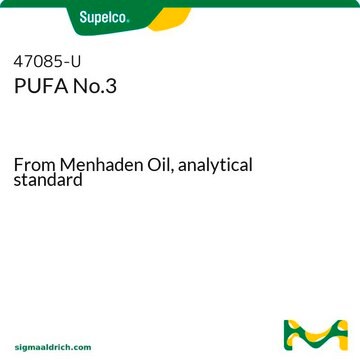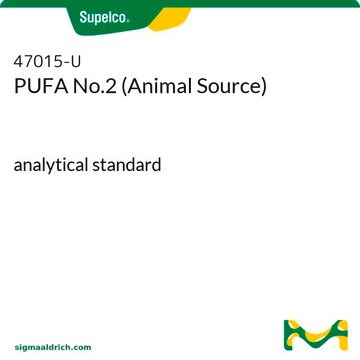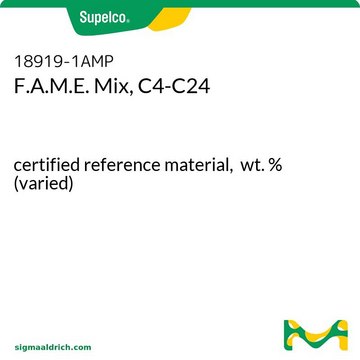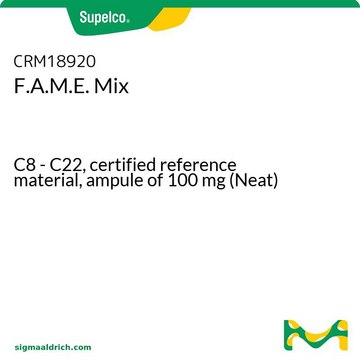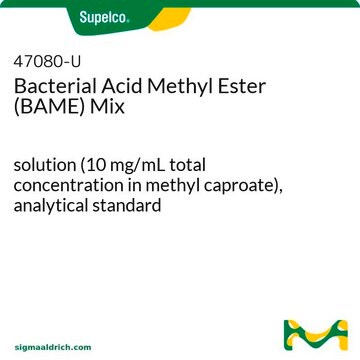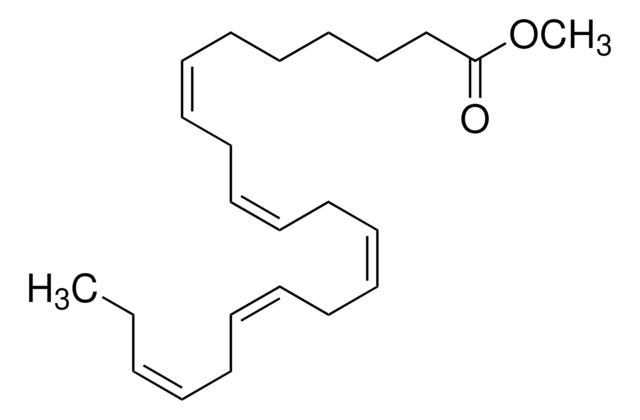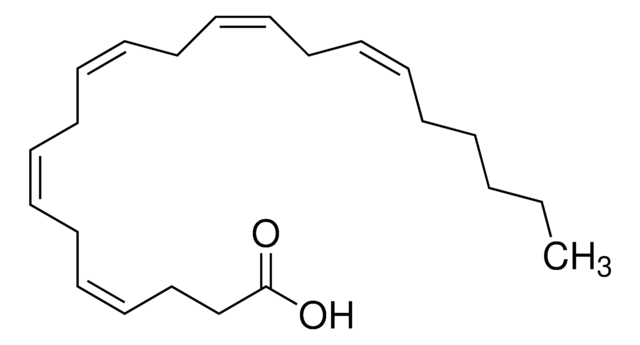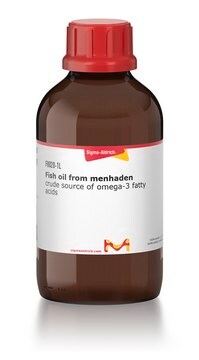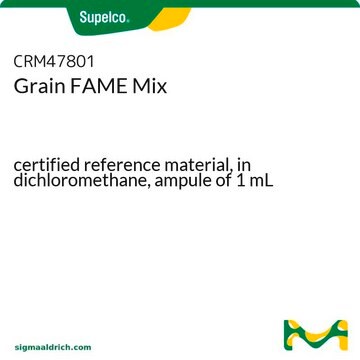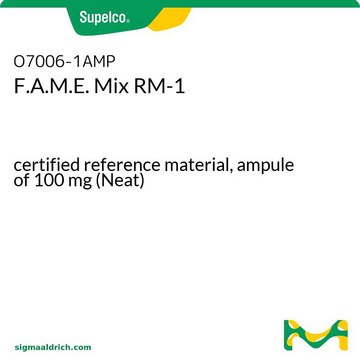47033
PUFA No.1
Marine source, analytical standard
Synonyme(s) :
Mélange d’acides gras polyinsaturés n° 1
Se connecterpour consulter vos tarifs contractuels et ceux de votre entreprise/organisme
About This Item
Code UNSPSC :
12164500
Produits recommandés
Source biologique
fish oil
Niveau de qualité
Qualité
analytical standard
CofA (certificat d'analyse)
current certificate can be downloaded
Conditionnement
pkg of 100 mg
Concentration
(varied concentration)
Technique(s)
HPLC: suitable
gas chromatography (GC): suitable
Application(s)
food and beverages
Format
neat
Conditions d'expédition
dry ice
Température de stockage
-10 to -25°C
Description générale
PUFA No.1 is a complex qualitative standard mixture. Because it is extracted from natural materials, relative peak size and composition may vary from lot to lot.
Application
Refer to the product′s Certificate of Analysis for more information on a suitable instrument technique. Contact Technical Service for further support.
Autres remarques
For qualitative identification only.
Product is extracted from natural sources. The fatty acid composition varies from lot-to-lot. The fatty acids listed below may or may not be present in the current lot. A representative chromatogram is supplied with product.
Certificate of Composition is not available on-line. Please contact your local Sigma-Aldrich office for documentation.
Product is extracted from natural sources. The fatty acid composition varies from lot-to-lot. The fatty acids listed below may or may not be present in the current lot. A representative chromatogram is supplied with product.
Certificate of Composition is not available on-line. Please contact your local Sigma-Aldrich office for documentation.
Analyte
Description
cis-4,7,10,13,16,19-Docosahexaenoic acid methyl ester
11-Docosenoic acid methyl ester
Methyl all-cis-7,10,13,16,19-docosapentaenoate
Methyl cis-13-docosenoate
Methyl all-cis-5,8,11,14,17-eicosapentaenoate
Methyl linoleate
Methyl myristate
Methyl oleate
Methyl palmitate
Methyl palmitoleate
Methyl stearidonate
cis-11-Octadecenoic methyl ester
Methyl cis-11-eicosenoate
Afficher tout (13)
Code de la classe de stockage
10 - Combustible liquids
Classe de danger pour l'eau (WGK)
WGK 1
Point d'éclair (°F)
Not applicable
Point d'éclair (°C)
Not applicable
Faites votre choix parmi les versions les plus récentes :
Déjà en possession de ce produit ?
Retrouvez la documentation relative aux produits que vous avez récemment achetés dans la Bibliothèque de documents.
Les clients ont également consulté
Celso Manuel Cristovão Mandume et al.
Foods (Basel, Switzerland), 8(7) (2019-06-30)
Despite being highly appreciated and consumed, the nutritional value of Chaceon maritae from Namibe (Angola) had never been studied. In the present work, edible tissues (muscle, ovaries, and hepatopancreas) of boiled female C. maritae caught off Namibe coast in two
Helena Oliveira et al.
Foods (Basel, Switzerland), 8(9) (2019-09-25)
Industrial cooking of common octopus (Octopus vulgaris) under well-established procedures is advantageous for current consumers, which demand healthy and convenient food. This work aimed to evaluate the effect of industrial water boiling, without the addition of salt, on the nutritional
José Luis Guil-Guerrero et al.
Chemistry & biodiversity, 17(12), e2000627-e2000627 (2020-10-13)
Thirty Boraginaceae species from different tribes were evaluated in a search of γ-linolenic (GLA, 18:3n-6) and stearidonic acid (SDA, 18:4n-3)-rich oils. The high GLA percentages were found in the seed oils of Symphytum bulbosum and S. tuberosum subsp. tuberosum (27.6
M J González-Fernández et al.
Biochimie, 139, 107-114 (2017-06-10)
Important health benefits have been attributed to monoacylglycerols (MAGs) due to their various physiological functions, owing to which they become candidates for use as functional foods in order to prevent the onset of certain diseases such as colon cancer. In
Laura Fernandes de Barros Marangoni et al.
Microorganisms, 7(10) (2019-10-12)
Ocean warming is one of the greatest global threats to coral reef ecosystems; it leads to the disruption of the coral-dinoflagellate symbiosis (bleaching) and to nutrient starvation, because corals mostly rely on autotrophy (i.e., the supply of photosynthates from the
Notre équipe de scientifiques dispose d'une expérience dans tous les secteurs de la recherche, notamment en sciences de la vie, science des matériaux, synthèse chimique, chromatographie, analyse et dans de nombreux autres domaines..
Contacter notre Service technique